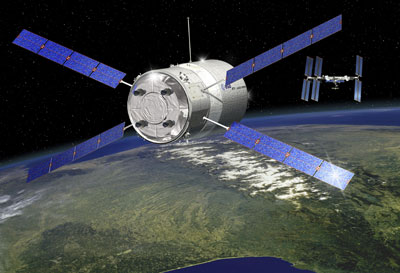Towards a European multitask space vehicleby Paul de Brem
|
| APEX will have not only an in-orbit rendezvous capability but will also be equipped to capture debris that might be difficult to grapple, such as tumbling objects. |
APEX—for Advanced Platform for EXploration—will be designed chiefly for the types of missions now performed by the European ATV (Automated Transfer Vehicle), which is slated to make its fifth and last flight in 2014. APEX will dock with the International Space Station (ISS), ferrying equipment, fuel, water and other supplies, raising its orbit and retrieving the station’s waste before making a controlled return to Earth.
Other variants of APEX could also get close to orbital debris such as spent launcher upper stages, map them in 3D using lidar and cameras, and assess their attitude before grabbing them. It could then deorbit the debris or carry them to a graveyard orbit, out of harm’s way for the ISS and operating satellites. To achieve this, APEX will have not only an in-orbit rendezvous capability but will also be equipped to capture debris that might be difficult to grapple, such as tumbling objects.
This sort of capability would prove useful for future international spaceflight missions. APEX could help to assemble spacecraft in Earth orbit for lunar or Mars exploration missions. Its technologies could also be used in Martian orbit to retrieve samples collected from the surface of the Red Planet by future missions. It could also conceivably resupply satellites before they run out of fuel.
Preliminary studies with the objective of designing a future OTV (Orbital Transfer Vehicle) have already been completed in Europe. Engineers from CNES and Astrium Space Transportation started work on the project in 2008. The German national space agency, DLR, has itself contemplated the launch of two satellites—an interceptor and its target—to facilitate various manoeuvres such as rendezvous and orbital capture in the context of the DEOS project (Deutsche Orbitale Servicing Mission). For CNES, a vehicle such as APEX would enable Europe to continue innovating in space matters and to maintain its ranking as the third space power. Thus, the concept is gaining traction.
| CNES intends to propose that ESA use the $600 million (€450 million) that Europe still owes NASA as its contribution to the ISS to fund work on APEX. |
However, no one knows what the APEX vehicle might look like. Indeed, it has not yet entered the design phase. In general terms, we can expect that it will be equipped with a more powerful thrust mechanism than that which equips the ATV. Powered by solar panels, onboard computers will manage guidance, navigation, and control. As to the systems enabling the grappling of non-cooperative objects, these have yet to be designed. In preliminary designs, American and European laboratories imagined the use of nets, harpoons, suction cups, or robotic arms.
To take APEX to the definition phase B, CNES will have to convince the other ESA member states to fund the program at the next meeting of space ministers in November. CNES intends to propose that ESA use the $600 million (€450 million) that Europe still owes NASA as its contribution to the ISS.
It is far from certain that NASA will accept the idea, as the US space agency would prefer to devote the money to another program. It would rather that ESA contribute to developing its Orion Multi-Purpose Crew Vehicle (MPCV), but France will reject this option since it will not spur sufficiently innovation in Europe.
Even if NASA does accept France’s proposal, the other European partner nations will have to make up the rest of the funding for APEX. The full development cost is estimated at around $1.3 billion (€1 billion)—and that kind of money is bound to prove hard to find in the period of economic turmoil that Europe is currently experiencing.
